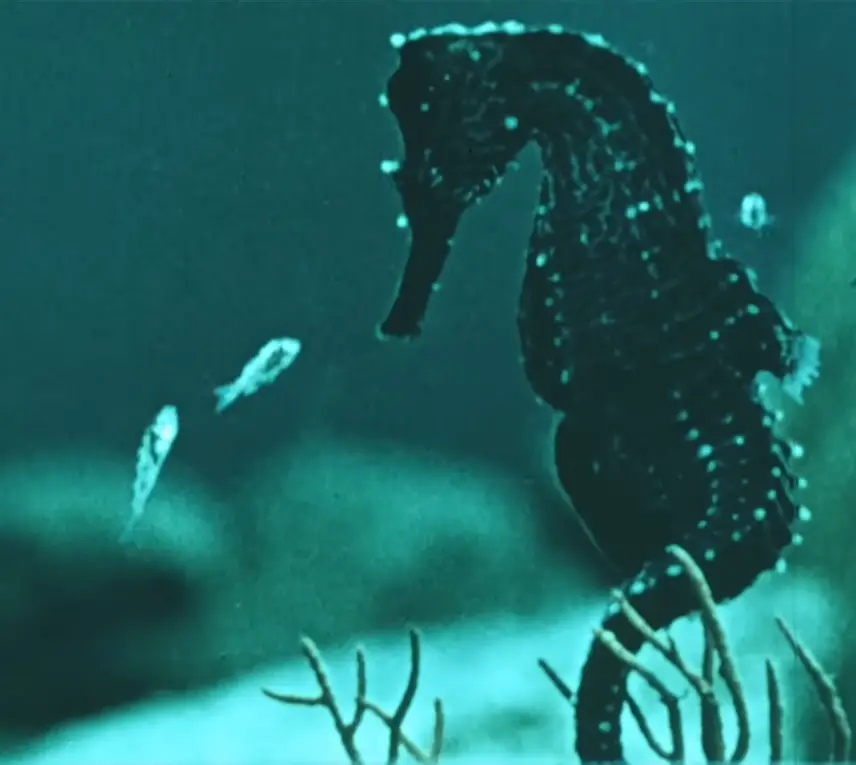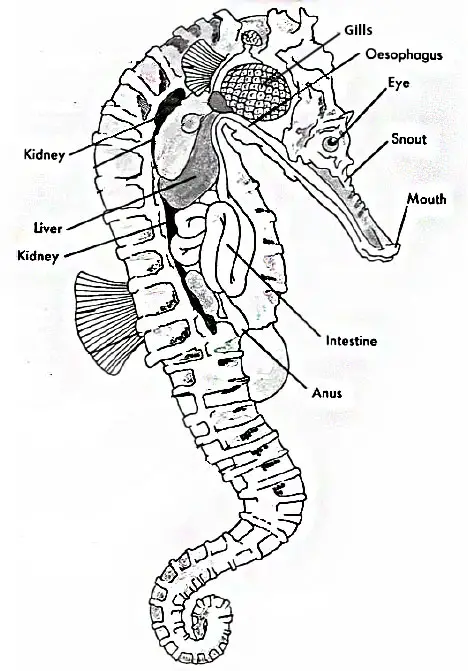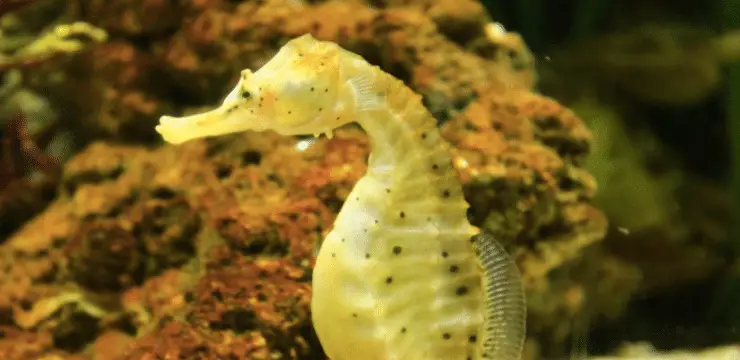As omnivores, seahorses usually feast on algae, crustaceans, phytoplankton, zooplankton, etc. What makes these creatures special is that they don’t have teeth or a stomach – meaning they need to continuously suck in food through their long snouts just to stay alive.
This article will explore more about what seahorses eat and how they do so, including some of their more unusual eating habits!
What Do Seahorses Eat?
Seahorses primarily eat small crustaceans, such as krill and copepods. They will also consume fish larvae, mysids, and other small floating creatures. Seahorses extend their long snouts to capture their prey and suck the animal into their mouths.
Seahorses also consume large amounts of plankton. Plankton is a general term that describes the various small, floating organisms that comprise many marine food chains. These tiny creatures include things like algae, bacteria, and protozoans.
You will wonder, knowing that parent seahorses eat their babies when there is not enough food around them.
What Seahorse Actually is: Carnivores or Herbivores?
There are so many doubts among people, like “Are seahorses herbivores? Are seahorses carnivores?” Well, the actual answer is – seahorses are omnivores. They eat both the sea plants and live foods like small fishes.
But, if you look into their food preference, they are primarily carnivores since most of their foods are amphipods, smaller shrimp, fish larvae, and others.
And when they become sick, or having digestion problems, or do not find their prey, then they become herbivores and consume see plants.
What Do Baby Seahorses Eat?
Young baby seahorses eat usually tiny crustaceans like brine shrimp and rotifers. They require a large diet in early life, similar to that of many other growing organisms. Over the course of 10 to 12 hours, a baby seahorse can ingest as many as 3,000 tiny copepods.
What Do Seahorses Eat in an Aquarium?
If you are keeping seahorses in aquariums, then you have to be more cautious about their regular meal. Although seahorses can survive without food for 1 week, it is not recommended. If you think, once a day is enough food for your seahorses, you are wrong.
When kept as pets in aquariums, seahorses require twice-daily feedings. Most seahorses need a diversified diet, however, they will happily eat a variety of frozen fish meals such as brine shrimp, Mysis shrimp, ghost shrimp, plankton, krill, and cyclops.
Remember, for seahorses the survival time without food always varies where they are living. And the ocean and aquarium are not the same, right? So, feed your seahorses accordingly.
How Do Seahorses Eat?
The eating and digestive process of seahorses are quite unique and interesting. Let’s take a closer look at the processes.
How does a seahorse catch its food?
The hunting style of seahorses is different from any other ocean life. As seahorses are poor swimmers, they can’t chase down their prey. So how do they catch their prey?
Instead of chasing down the prey, while hiding in the coral or sea grass, they close to the target very slowly, snap their head around, and, within a blink of an eye, suck the prey up through their snout.

This technique is known as pivot feeding, and seahorses are the champions of the technique. Seahorses catch their prey in such a short time that your eyes cannot even recognize any change.
To make up for its slow swimming, a seahorse has a long, flexible neck that it may use to grasp prey. It also has a prehensile tail that it uses to curl around objects and anchor itself in place.
So as not to be seen, they frequently resorted to camouflage. The seahorse will swivel its head and gulp down its meal all at once. The sound produced by this action is unique.
How do seahorses chew their food without teeth?
Seahorses are toothless. So, they must take their food in through their nostrils and digest it whole. Therefore, they can only eat very small animals. Typically, seahorses eat plankton, tiny fish, and small crustaceans like shrimp and copepods.
Seahorses are also unique in the way they digest their food. Unlike other animals, seahorses do not have a stomach. Instead, food passes through their digestive system relatively quickly.
Interestingly, seahorses also can store food in their tail for a short period. When they cannot find enough food, they can rely on this stored food to help them get through tough times.
How Often Do Seahorses Eat?
Seahorses must frequently eat because they lack a stomach. In fact, seahorses can eat up to three times their body weight in a single day! This means they constantly graze on small food items throughout the day.
Where adult seahorses consume food 30–50 times daily, juveniles consume up to 3,000 food items daily. Moreover, seahorses do not have a way to store extra energy, so they must often eat to maintain their metabolism and energy levels.
While seahorses graze throughout the day, they typically have mini-feasts at dawn and dusk. At these times, they will consume larger amounts of food items in one sitting. This helps them tide over the hours when food is scarce.
How Do Seahorses Digest Their Food?
Seahorses eat tiny pieces of food, which go into their intestines through their mouths. After sucking the food, seahorses break it up physically in the throat before entering the intestine and digesting it by pancreatic and intestinal enzymes.
Bacteria in the intestine help break down food, and the seahorse gets rid of what it hasn’t digested through its vent, which is just below the tail.

How does this process work? The bacteria in the intestine produce enzymes that help digest food.
These enzymes break down the food into small pieces that the seahorse’s body can absorb. The bacteria also produce vitamins and other nutrients that the seahorse needs to stay healthy.
Can Seahorses Live a Week Without Food?
Seahorses can live for up to a week without food, but they will eventually start to feel the effects of hunger. These creatures need to eat small meals several times daily to get the necessary nutrients.
If you’re wondering how much food a seahorse needs, it’s very little. A single seahorse can eat up to 3000 pieces of plankton in one day!
While seahorses mostly eat small creatures like plankton, they will also consume larger prey if available. Seahorses are known to eat shrimp, crab, and other fish.
But seahorses don’t eat as many big meals because they prefer to wait for small animals to come close. In this regard, you may check our article on “how long can seahorses go without food?“
FAQs
When do seahorses stop eating?
Basically, seahorses never really stop eating. They just slow their eating when there is not as much food available. However, they may stop for a while if they become weak or arrive in any physical condition.
Exceptionally, seahorses stop eating when they are ready to mate. During this time, the male seahorse will stop eating for up to two weeks to prepare for the mating ritual. Once the ritual is complete, the seahorse will resume its normal eating habits.
What is the impact of seahorses on the ocean ecosystem?
Seahorses play an important role in the ocean ecosystem. They help to control the population of small floating creatures like krill, copepods, and fish larvae. Seahorses help keep the ocean clean and healthy by eating these animals.
In addition, seahorses are a food source for many other animals in the ocean, including sharks, turtles, and other fish. Without seahorses, the ocean ecosystem would be out of balance. Seahorses are an important part of the food chain and help to keep the ocean healthy.
Conclusion
So, hopefully, now you know how seahorses eat as they lack both teeth and a stomach. Instead, they suck in their prey with their long snouts. Seahorses eat small crustaceans, such as krill, copepods, and plankton.
Seahorses graze throughout the day but typically have mini feasts at dawn and dusk. Seahorses can live for up to a week without food, but they will eventually start to feel the effects of hunger.


6 thoughts on “What Do Seahorses Eat and How?”